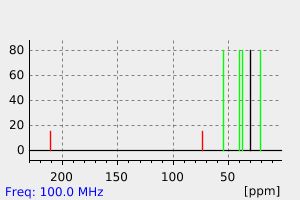3-hydroxy-3-methylcyclohexan-1-one | 68165-43-5
中文名称
——
中文别名
——
英文名称
3-hydroxy-3-methylcyclohexan-1-one
英文别名
3-hydroxy-3-methylcyclohexanone;Hydroxy-3-methyl-3-cyclohexanon
CAS
68165-43-5
化学式
C7H12O2
mdl
——
分子量
128.171
InChiKey
DXBLIKWIRLTTDK-UHFFFAOYSA-N
BEILSTEIN
——
EINECS
——
-
物化性质
-
计算性质
-
ADMET
-
安全信息
-
SDS
-
制备方法与用途
-
上下游信息
-
文献信息
-
表征谱图
-
同类化合物
-
相关功能分类
-
相关结构分类
物化性质
-
沸点:222.1±33.0 °C(Predicted)
-
密度:1.082±0.06 g/cm3(Predicted)
计算性质
-
辛醇/水分配系数(LogP):0
-
重原子数:9
-
可旋转键数:0
-
环数:1.0
-
sp3杂化的碳原子比例:0.86
-
拓扑面积:37.3
-
氢给体数:1
-
氢受体数:2
SDS
反应信息
-
作为反应物:描述:参考文献:名称:分子内羟醛缩合:速率和平衡常数摘要:已经确定了 2,5-己二酮、2,6-庚二酮、1-苯基-1,5-己二酮和 5-氧代己醛的分子内缩合反应中的醛醇加成和消除步骤的速率和平衡常数。2,5-己二酮和2,6-庚二酮环化的整体热力学相似;2,5-己二酮转化为相应的烯酮实际上更有利,但2,5-己二酮的环化比2,6-庚二酮慢2400倍。正如基于分子间类似物所预期的那样,1-苯基-1,5-己二酮的加成步骤不太有利且较慢,5-氧代己醛的加成步骤更有利,但速率与庚二酮相似。详细分析所有这些化合物以及 2-(2-氧代丙基)苯甲醛的动力学和平衡,就马库斯理论而言,分子内反应导致与之前分子间反应相同的内在障碍。这我...DOI:10.1021/ja954247l
-
作为产物:描述:6-甲基-7-氧杂双环[4.1.0]庚烷-2-酮 在 naphthalen-1-yl-lithium 作用下, 以 四氢呋喃 为溶剂, 反应 0.25h, 以78%的产率得到3-hydroxy-3-methylcyclohexan-1-one参考文献:名称:Lithium naphthalenide induced reductive cleavage of α,β-epoxy ketones: an efficient procedure for the preparation of β-hydroxy ketones摘要:萘基锂化合物作为一种温和且高效的试剂,能够有效地切割α,β-环氧酮,从而以良好的产率生成相应的β-羟基酮。DOI:10.1039/a904646a
文献信息
-
PREPARATION OF 2,3-EPOXYCYCLOALKANONES FROM BICYCLO[<i>n</i>.1.0]ALKAN-1-OLS作者:Jean-Pierre Barnier、Vèronique Morisson、Luis BlancoDOI:10.1081/scc-100000523日期:2001.1Copper- or iron-catalyzed oxidative rearrangement of bicy- clo[n.1.0]alkan-1-ols yields 3-hydroperoxycycloalkanones and/or bicyclic peroxyhemiketals, which are transformed into 2,3-epoxy- cycloalkanones by treatment with a base.
-
[EN] PYRAZOLO[1,5-A]PYRIDINES AS MARK INHIBITORS<br/>[FR] PYRAZOLO[1,5-A]PYRIDINES EN TANT QU'INHIBITEURS DE MARK申请人:MERCK & CO INC公开号:WO2010017046A1公开(公告)日:2010-02-11The invention encompasses pyrazolo[1,5-a]pyridine derivatives which selectively inhibit microtubule affinity regulating kinase (MARK) and are therefore useful for the treatment or prevention of Alzheimer's disease. Pharmaceutical compositions and methods of use are also included.
-
NOVEL NONLINEAR CHROMOPHORES ESPECIALLY SUITED FOR USE IN ELECTRO-OPTICAL MODULATION申请人:Bretonniere Yann公开号:US20130123508A1公开(公告)日:2013-05-16The present invention relates to heptamethine hemicyanine chromophores of formula (I): where R 1 , R 2 , R 3 , R 4 , R′ 4 , R 5 , R′ 5 , R 6 , R′ 6 , R 7 , X, Y 1 and Y 2 are as defined in claim 1 , to the method for preparing same as well as to the use of such chromophores for the second-order nonlinear optical property thereof.
-
Scalable, Electrochemical Oxidation of Unactivated C–H Bonds作者:Yu Kawamata、Ming Yan、Zhiqing Liu、Deng-Hui Bao、Jinshan Chen、Jeremy T. Starr、Phil S. BaranDOI:10.1021/jacs.7b03539日期:2017.6.7A practical electrochemical oxidation of unactivated C–H bonds is presented. This reaction utilizes a simple redox mediator, quinuclidine, with inexpensive carbon and nickel electrodes to selectively functionalize “deep-seated” methylene and methine moieties. The process exhibits a broad scope and good functional group compatibility. The scalability, as illustrated by a 50 g scale oxidation of sclareolide
-
Heterogeneous versus Homogeneous Copper(II) Catalysis in Enantioselective Conjugate-Addition Reactions of Boron in Water作者:Taku Kitanosono、Pengyu Xu、Shū KobayashiDOI:10.1002/asia.201300997日期:2014.1reported for the conjugate addition of boron. Heterogeneous cat. 1 also gave high yields and enantioselectivities with some substrates and also gave the highest TOF (43 200 h−1) for an asymmetric conjugate‐addition reaction of boron. In addition, the catalyst systems were also applicable to the conjugate addition of boron to α,β,γ,δ‐unsaturated carbonyl compounds, although such reactions have previously我们已经开发了Cu II催化的硼在水中与α,β-不饱和羰基化合物和α,β,γ,δ-不饱和羰基化合物的对映体共轭加成反应。与先前报道的需要有机溶剂的Cu I催化相反,发现手性Cu II催化在水中有效地进行。已经开发了三种催化剂体系:催化剂。1:具有手性配体L 1的Cu(OH)2;猫。2:具有配体L1的Cu(OH)2和乙酸;和猫。3:具有配体L1的Cu(OAc)2。而猫。1是异构系统,猫。2和猫。3是同质系统。我们测试了27种α,β-不饱和羰基化合物和α,β-不饱和腈化合物,包括无环和环状α,β-不饱和酮,无环和环状β,β-二取代的烯酮,无环和环状α,β-不饱和酯(包括其β,β-二取代形式)和无环α,β-不饱和酰胺(包括其β,β-二取代形式)。我们找到那只猫。2和猫。图3显示了几乎所有底物的高产率和对映选择性。值得注意的是,没有报道过能以高收率和高对映选择性耐受所有这些底物的催化剂。异类猫。1
表征谱图
-
氢谱1HNMR
-
质谱MS
-
碳谱13CNMR
-
红外IR
-
拉曼Raman
-
峰位数据
-
峰位匹配
-
表征信息
同类化合物
(反式)-4-壬烯醛
(s)-2,3-二羟基丙酸甲酯
([1-(甲氧基甲基)-1H-1,2,4-三唑-5-基](苯基)甲酮)
(Z)-4-辛烯醛
(S)-氨基甲酸酯β-D-O-葡糖醛酸
(S)-3-(((2,2-二氟-1-羟基-7-(甲基磺酰基)-2,3-二氢-1H-茚满-4-基)氧基)-5-氟苄腈
(R)-氨基甲酸酯β-D-O-葡糖醛酸
(5,5-二甲基-2-(哌啶-2-基)环己烷-1,3-二酮)
(2,5-二氟苯基)-4-哌啶基-甲酮
龙胆苦苷
龙胆二糖甲乙酮氰醇(P)
龙胆二糖丙酮氰醇(P)
龙胆三糖
龙涎酮
齐罗硅酮
齐留通beta-D-葡糖苷酸
鼠李糖
黑芥子苷单钾盐
黑海棉酸钠盐
黑木金合欢素
黑曲霉三糖
黑介子苷
黄尿酸8-O-葡糖苷
麻西那霉素II
麦迪霉素
麦芽糖脎
麦芽糖基海藻糖
麦芽糖1-磷酸酯
麦芽糖
麦芽四糖醇
麦芽四糖
麦芽十糖
麦芽六糖
麦芽五糖水合物
麦芽五糖
麦芽五糖
麦芽五糖
麦芽三糖醇
麦芽三糖
麦芽三糖
麦芽三塘水合
麦芽七糖水合物
麦芽七糖
麦法朵
麦可酚酸-酰基-Β-D-葡糖苷酸
麦利查咪
麝香酮
鹤草酚
鸢尾酚酮 3-C-beta-D-吡喃葡萄糖苷
鸡矢藤苷







